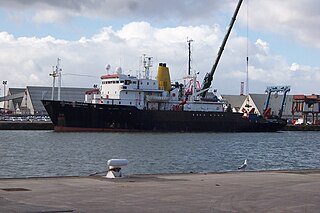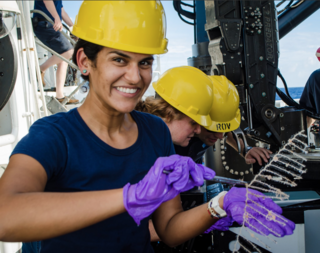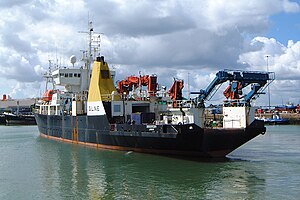
The RRS Discovery is a barque-rigged auxiliary steamship built in Dundee, Scotland for Antarctic research. Launched in 1901, she was the last traditional wooden three-masted ship to be built in the United Kingdom. Her first mission was the British National Antarctic Expedition, carrying Robert Falcon Scott and Ernest Shackleton on their first, and highly successful, journey to the Antarctic, known as the Discovery Expedition.

The National Oceanography Centre (NOC) is a marine science research and technology institution based on two sites in Southampton and Liverpool, England. It is the UK’s largest institution for integrated sea level science, coastal and deep ocean research and technology development. The Centre was established to promote cooperation with institutions across the UK marine science community, to better address key issues including sea level change, the ocean's role is climate change, computer simulation of the ocean's behaviour, and the long term monitoring and future of the Arctic Circle.

The RRS Charles Darwin was a Royal Research Ship belonging to the British Natural Environment Research Council. Since 2006, she has been the geophysical survey vessel, RV Ocean Researcher,
A Royal Research Ship (RRS) is a merchant navy vessel of the United Kingdom that conducts scientific research for His Majesty's Government. Organisations operating such ships include; the Natural Environment Research Council (NERC), the British Antarctic Survey (BAS) and the National Oceanography Centre (NOC). A warrant from the monarch is required before a ship can be designated as an RRS.
The Natural Environment Research Council (NERC) has seven subject-based environmental data centres (EDCs) to store and distribute data from its own research programmes and data that are of general use to the environmental research community. These data centres are sometimes called the NERC designated Data Centres.

Sir George Edward Raven Deacon CBE FRS FRSE was a British oceanographer and chemist.
The British Antarctic Survey (BAS) is the United Kingdom's national polar research institute. It has a dual purpose, to conduct polar science, enabling better understanding of global issues, and to provide an active presence in the Antarctic on behalf of the UK. It is part of the Natural Environment Research Council (NERC). With over 400 staff, BAS takes an active role in Antarctic affairs, operating five research stations, one ship and five aircraft in both polar regions, as well as addressing key global and regional issues. This involves joint research projects with over 40 UK universities and more than 120 national and international collaborations.

The RRS James Cook is a British Royal Research Ship operated by the Natural Environment Research Council (NERC). She was built in 2006 to replace the ageing RRS Charles Darwin with funds from Britain's NERC and the DTI's Large Scientific Facilities Fund. She was named after Captain James Cook, the British explorer, navigator and cartographer at the National Oceanography Centre, Southampton by The Princess Royal.

ORV Sagar Nidhi is an ice-strengthened multidisciplinary vessel operated by the National Institute of Ocean Technology, India. It was constructed at Fincantieri, Italy. The 104-metre-long vessel has fully automatic diesel-electric propulsion equipped with dynamic positioning system, azimuth thrusters, and a winch to hoist 60 tonnes from a depth of 6,000 metres.

RRS Shackleton was a Royal Research Ship operated by the British scientific research organisations the Falkland Islands Dependencies Survey (FIDS), British Antarctic Survey (BAS) and Natural Environment Research Council (NERC) in the Antarctic from 1955 to 1983. She was subsequently operated as a seismic survey vessel under the names Geotek Beta, Profiler and finally Sea Profiler before being scrapped in 2011.
RRS Discovery II was a British Royal Research Ship which, during her operational lifetime of about 30 years, carried out considerable hydrographical and marine biological survey work in Antarctic waters and the Southern Ocean in the course of the Discovery Investigations research program. Built in Port Glasgow, launched in 1928 and completed in 1929, she was the first purpose-built oceanographic research vessel and was named after Robert Falcon Scott's 1901 ship, RRS Discovery.

RRS Discovery is a Royal Research Ship operated by the Natural Environment Research Council. The ship is the third such vessel to be built and named for the ship used by Robert Falcon Scott in his 1901-1904 expedition to the Antarctic.

The British Mid-Ocean Ridge Initiative was a multidisciplinary scientific investigation of the creation of the Earth’s crust in the deep oceans. It was funded by the UK’s Natural Environment Research Council (NERC) from 1993 to 1999.

Boaty McBoatface is the British lead boat in a fleet of three robotic lithium battery–powered autonomous underwater vehicles (AUVs) of the Autosub Long Range (ALR) class. Launched in 2017 and carried on board the polar scientific research vessel RRS Sir David Attenborough, she is a focal point of the Polar Explorer Programme of the UK Government.

RRS Sir David Attenborough is a research vessel owned by the Natural Environment Research Council and operated by the British Antarctic Survey for the purposes of both research and logistic support. The ship replaces a pair of existing vessels, RRS James Clark Ross and RRS Ernest Shackleton. The vessel is named after broadcaster and naturalist Sir David Attenborough.

Karen Joy Heywood is a British Antarctic oceanographer and Professor of Physical Oceanography at the University of East Anglia (UEA). She is best known for her work developing autonomous measurements of the Southern Ocean.
Rachel Ann Mills is a Professor of Ocean Chemistry at the University of Southampton. She is a deep-sea oceanographer who works on the chemistry of the seafloor and its impact on life in the sea. She has led research expeditions using submersibles and remotely operated vehicles to remote and deep, unexplored parts of the ocean.

Diva Joan Amon is a marine biologist from Trinidad. She is currently a post-doctoral researcher in the Benioff Ocean Initiative at the University of California, Santa Barbara and a 2022 Pew Marine Fellow. Previously, she was a Marie Skłodowska-Curie Actions (MSCA) Research Fellow at the Natural History Museum, London.














